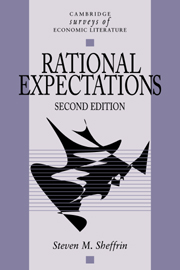Book contents
6 - Rational expectations in practice
Published online by Cambridge University Press: 05 June 2012
Summary
Two important political episodes, separated by more than a decade, highlight the key role that expectations play and the limits to our understanding of these expectations. Rational expectations reasoning played a prominent role in the first years of the administrations of both President Ronald Reagan and President Bill Clinton.
Most political observers are accustomed to optimistic economic forecasts from the executive branch of the U.S. government. They were not, however, quite prepared for the first forecasts or “scenarios” concocted by economists associated with the Reagan Administration. These forecasts suggested that inflation would fall from the double-digit levels prevailing during 1981 to 6.5 percent by 1982 and 4.5 percent by 1983. This dramatic reduction in inflation was not intended to be the consequence of a massive recession. On the contrary, real output was predicted to grow rapidly at the same time that inflation was falling.
This feat was to be accomplished by Reagan's proposed economic plan, consisting of personal and corporate tax cuts, regulatory reform, and a sustained reduction in the rate of money growth. Existing econometric models did not predict so rosy an economic scenario from this plan as did administration forecasts. The combination of “easy” fiscal policy and “tight” money was viewed by some forecasters to be, on net, stimulative and to lead to an increase rather than a decrease in the inflation rate. Other forecasters foresaw a collision between these monetary and fiscal policies leading to high interest rates and diminished growth.
- Type
- Chapter
- Information
- Rational Expectations , pp. 157 - 168Publisher: Cambridge University PressPrint publication year: 1996

